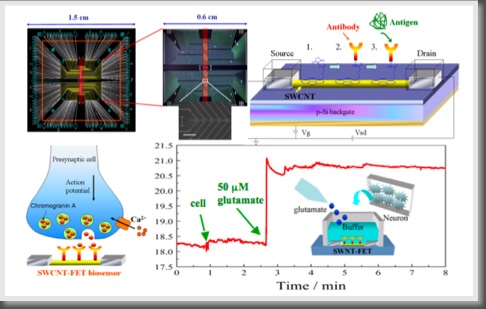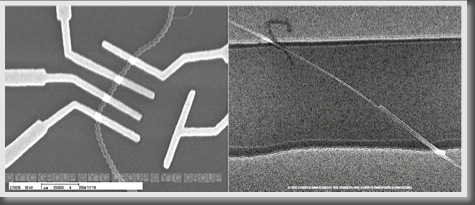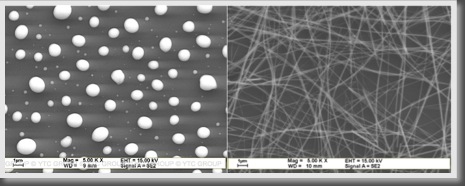Nanoscale Materials and Bioanalytical Chemistry Laboratory
Research - NT/NW-FET
1. Biosensory Applications of NT/NW-FET
Single-walled carbon nanotube field-effect transistor (SWCNT-FET) has been used to monitor the synaptic transmissions among primary cultured embryonic cortical neurons. Chromogranin A (CgA), one of the molecules released from secretory vesicles when the vesicles are fused with plasma membrane, is a diagnostic marker for neuroendocrine tumors and neurodegenerative diseases like Parkinson’s and Alzheimer’s diseases. Therefore, the detection of CgA is an excellent indicator of synaptic activity when synaptic vesicle at the presynaptic terminal is triggered to undergo exocytosis.
We have demonstrated that the CgA released from the synaptic terminal of living neurons, stimulated by glutamate, can be detected in situ by the CgA-antibody modified SWCNT-FET with high selectivity (as displayed in the following figure). The low amount of CgA released from cultured neurons could not be monitored by immunoassay kits. Neither could it be detected with a Western blot in bath buffer. This label-free and highly sensitive SWCNT-FET biosensor, capable of measuring the immediate vicinity release of CgA from neurons, is promising in medical examination and can further be applied to study the activity of individual neurons (C.-W. Wang et al., Small, 3, 1350-1355 (2007)). We have closely cooperated with Dr. Chii-Dong Chen (Institute of Physics, Academia Sinica) and Dr. Chien-Yuan Pan (Institute of Zoology, National Taiwan University)

2. Electric Transport in NT/NW-FET
Taking advantage of modern MEMS/NEMS technology, we have successfully fabricated NT/NW-FET configured with various semiconductor materials. We performed experiments to determine the electrical transport properties of single semiconducting NT/NW.

3. One-dimensioal Nanomaterials
Using a chemical vapor deposition (CVD) method, we synthesize one-dimensional single-crystalline nanowires, nanorods, nanobelts, nano-springs, and superlattices via catalyst-assisted growth. These nanostructures exhibit interesting morphologies and optical properties, such as surface enhanced Raman scattering (SERS) and polarized photo-luminescence (PL).

